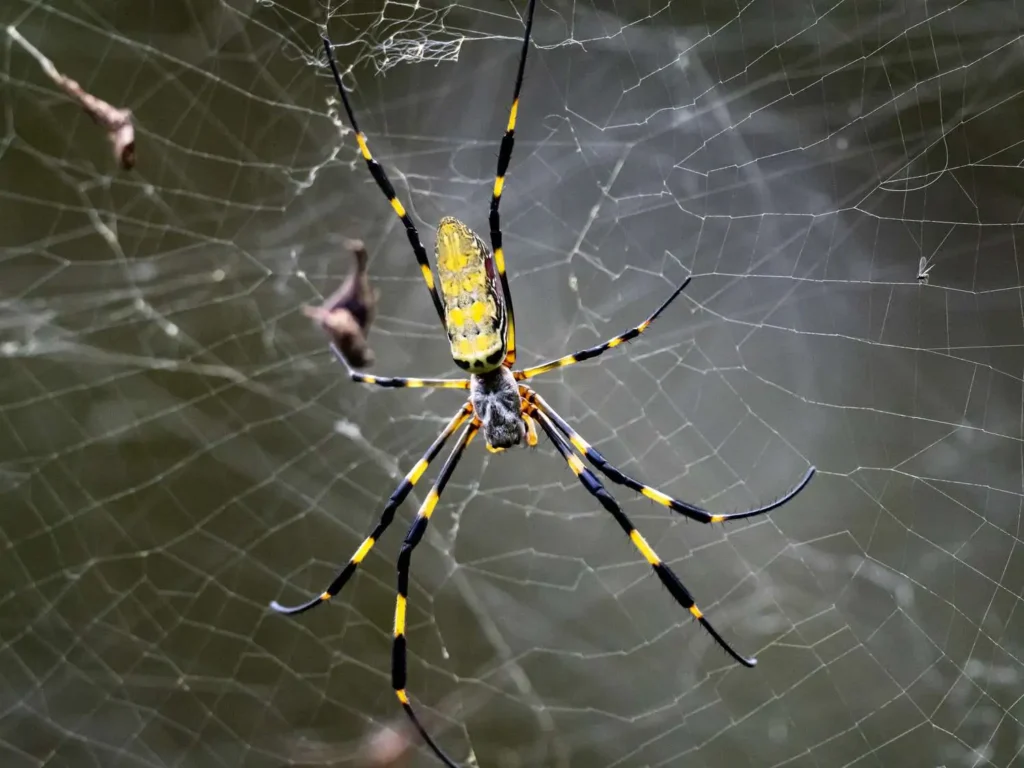Introduction
The Joro spider, a colorful invasive species from East Asia, is spreading in the U.S., mainly in the South and East Coast. Although some people find them alarming, experts like David Nelsen from Southern Adventist University believe they shouldn’t be a major worry. Nelsen suggests that people are drawn to the spider because of its unusual appearance and potential danger, which can spark unnecessary fear.
Concerns About Invasive Pests
Scientists are more concerned about other invasive pests that damage crops and trees. Global trade and climate change are worsening these problems by making it easier for pests to thrive. Hannah Burrack from Michigan State University views the Joro spider as a “canary in the coal mine,” signaling larger issues with invasive species. While the Joro spider itself is not a big threat to humans, pests like fruit flies and tree borers pose more significant risks.
About the Joro Spider
The Joro spider, part of the orb-weaver group, is native to East Asia and has striking yellow and black colors. It grows up to three inches long but is still small and hard to see this time of year. Their webs, about the size of a softball, can be found on porches or in grass. They are most noticeable in late summer and early fall.
Spread and Movement
Scientists are tracking their spread, which started in Atlanta and is moving to nearby areas like the Carolinas and southeastern Tennessee. They have also been found in Baltimore, but it’s uncertain when they’ll reach the Northeast. The spiders can travel long distances as babies using a technique called “ballooning,” but adults cannot fly.
Diet and Impact
Joro spiders eat insects that land in their webs, potentially competing with native spiders for food. However, they might also benefit local bird species. They won’t significantly reduce the population of invasive pests like spotted lanternflies.
Threat to Humans
Joro spiders have venom but aren’t dangerous to humans. Their bites might cause itching or mild allergic reactions, but they usually avoid people. More concerning for human health are other invasive species that threaten natural resources. Overall, the Joro spider highlights the broader issue of ecological damage caused by human activities.
A large, brightly colored invasive species known as the Joro spider is expanding its presence in the United States. Populations have been increasing in the South and along the East Coast for years, and many researchers believe it’s only a matter of time before they spread across much of the continental U.S.
However, experts assure that there’s no need for alarm.

“People tend to be fascinated by the unusual and potentially dangerous,” said David Nelsen, a biology professor at Southern Adventist University who has studied the Joro spider’s expanding range. “This situation ticks all the boxes for public hysteria.”
Scientists are more concerned about the rise of invasive species that harm crops and trees. Global trade and climate change exacerbate this problem by creating favorable conditions for pests that previously couldn’t survive cold winters. Hannah Burrack, chair of the entomology department at Michigan State University, explained that while the Joro spider gets a lot of attention, it poses little risk to humans. In contrast, pests like fruit flies and tree borers are far more destructive.
“This is a global issue, complicating our efforts in conservation, agriculture, and human health,” Burrack said.
What is the Joro Spider?
The Joro spider is an orb-weaver, named for its wheel-shaped webs. Native to East Asia, these spiders have bright yellow and black coloring and can grow up to three inches (8 cm) with their legs fully extended. Currently, they’re small—about the size of a grain of rice—but trained eyes can spot their webs on porches or their silk threads on the grass. Adults are most commonly seen in August and September.
Where Are They Headed?
Scientists are still determining their spread. David Coyle, an assistant professor at Clemson University, noted that the Joro spider’s central population is in Atlanta but is expanding into the Carolinas and southeastern Tennessee. A satellite population has been established in Baltimore over the past two years. The timeline for their prevalence in the Northeast is uncertain, potentially taking years of incremental spread.
Can They Fly?
Young Joro spiders can “balloon” by using their webs to catch the wind and electromagnetic currents, allowing them to travel long distances. However, adult Joro spiders do not fly.
What Do They Eat?
Joro spiders consume whatever lands in their web, primarily insects. This could lead to competition with native spiders for food, but it also means they could feed native bird species. However, hopes that Joro spiders could significantly reduce invasive spotted lanternfly populations are unfounded, as they might eat a few but won’t significantly impact their numbers.
Are They Dangerous to Humans?
Joro spiders have venom like all spiders, but they are not dangerous to humans. A bite might cause itching or an allergic reaction, but these shy creatures usually avoid human contact.
The real threat comes from other invasive species like the emerald ash borer and the spotted wing drosophila fruit fly, which jeopardize natural resources. Andy Davis, a research scientist at the University of Georgia, emphasized the broader ecological damage caused by human activity, noting that the Joro spider is just one more example of this influence.
“I try to remain scientifically objective to protect myself from the sadness of it,” Davis said. “But there’s so much ecological damage being done worldwide for many reasons, mostly due to humans.”
